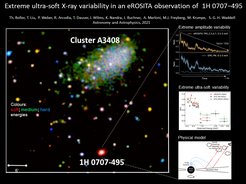Thomas Boller
"The eROSITA project will keep me busy for a few years"

Life
My name is Thomas Boller, I’m a researcher at the high energy astrophysics group at the Max Planck Institute for Extraterrestrial Physics and a professor for astrophysics at the Goethe University in Frankfurt. I am also a member of the International Max-Planck Research School (IMPRS) on Astrophysics, where I select and mentor outstanding students and give lectures. I have been awarded with the “Michael and Biserka Baum Preis” for outstanding research on Active Galactic Nuclei at MPE and excellent teaching at the Goethe University Frankfurt. I am a full member of the Academia Europaea, Section Physics and Engineering since 2011.
Science
I’m especially interested in AGN Physics, matter under strong gravity and Narrow-Line Seyfert 1 research. In 2016 me and my colleagues have published an advanced version of the ROSAT catalogue of point sources (2RXS) in preparation of the eROSITA mission and I have published highly cited papers based on ROSAT and XMM-Newton observations. Regarding eROSITA, my focus lies on X-ray variability and I am now actively working on the scientific exploration of the eROSITA mission.

Central panel: eROSITA RGB image of the field of view of the CalPV observations (0.2-0.7 (soft band, red), 0.7-1.5 (medium band, green), and 1.5-5 keV (hard band (blue)). Besides the primary target 1 H0707-495, the galaxy cluster A3408 has been detected for the first time with high spatial resolution. We also note the detection of a hard (blue) and probably obscured source population only detected above 1.5 keV.
Upper right panel: During the eROSITA observations, 1H 0707-495 showed a dramatic flux drop in about one day by a factor of about 100, a rare phenomenon in astrophysics.
Middle right panel: Normalized excess variance spectra (NEV) calculated for eROSITA, EPIC-pn, and EPIC-MOS2. All spectra show the same shape, with significant variability up to 0.8 keV followed by a sharp drop downwards between 0.8 and 2.0 keV. Such ultra-soft X-ray variability has been detected for the first time with eROSITA.
Bottom right panel: Illustration of the considered physical scenario. Above a spinning black hole, X-rays are emitted isotopically. Because of the compact corona very close to the black hole, the majority of the photons either hit the accretion disc or fall into the black hole. From the high- to the low-flux state, a partial coverer is obscuring and increasing part of the emitted X-ray radiation. The absorber is probably ionized and therefore more transparent in the soft X-rays than neutral absorbers. This results into leakage effects in the soft X-rays, explaining the ultra-soft light curve.
Future Projects
I am sure; the eROSITA project will keep me busy for a few years. Additionally, I keep on giving lectures to students as a Professor for Astrophysics at the Goethe-University Frankfurt and at the International Max-Planck Research School at MPE.
Conclusion
In 1988, I was invited to visit the MPE by Prof. Joachim Trümper, but with the Berlin Wall still existing, the Eastern Government did not allow me to travel. After the fall of the Berlin Wall, I started working at the MPE in 1990. In my spare time, I like to play the piano and act as radio ham.













